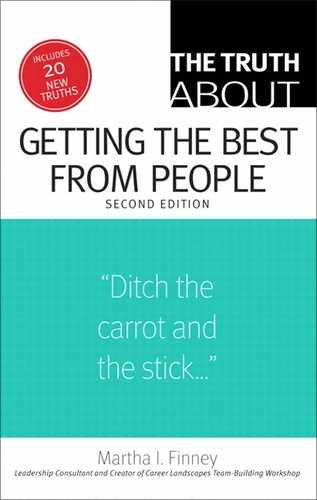Truth 56. Open questions ignite inspiring answers
In his 1996 book Only the Paranoid Survive, Intel CEO and cofounder Andy Grove told the story of how in the 1980s, he posed the following question to his partner Gordon Moore, “If we got kicked out and the board brought in a new CEO, what would he do?” Moore’s answer was quick and decisive: The hypothetical CEO would get the company out of the memory chip business. So Grove proposed that they “fire” themselves, return as their own replacements, and do just what the new CEO would do. So they did, transforming Intel into a microprocessor maker. And that’s why today most of us have “Intel inside” on our computers.
Good questions help us do our jobs better. Journalism students are trained to write their articles based on information gathered by five fundamental questions: Who? What? When? Where? Why? (With How? thrown in for good measure; business journalists, of course, ask “How much?”) Those are the questions that measure and report on the past—which is the appropriate task of the journalist, who isn’t paid to change the future. The journalist’s old bag of tricks is certainly useful in helping you identify and measure progress and failure to date. And it will absolutely help you decide whom to assign the credit or the blame. But it won’t help you get out of the spin cycle of the past and fling off into an entirely new set of possibilities.
The business leader must ask the question that springboards change. And that’s the question that Grove posed to Moore: “What if?”
The question “what if” will help you open a variety of doors to different versions of the future. When Moore answered Grove’s “what if” question, for instance, Intel marched into an entirely different destiny. “What if” is your essential tool for reinventing your organization, reassessing your current circumstances using a more forward-looking set of variables, opening your mind to alternative interpretations of current circumstances, realigning your employees to a new vision, and rededicating everyone’s passion to a new mission.
The business leader must ask the question that springboards change.
Here are some “what if” questions to try when you’re ready to slough off the same old set of problems and take on an entirely new challenge:
“What if” is your essential tool for reinventing your organization.
• What if there’s a better answer?
• What if there’s a simpler approach?
• What if there’s an entirely different way to interpret the meaning behind this problem?
• What if this failure is actually a great solution to a different problem?
• What if there is more than one solution?
• What if my team was given the chance to rehire me tomorrow?
• What if they could fire me instead?
• What if all my employees had to reapply for their jobs tomorrow?
• What if my employees met our customers face to face?
“What if” questions can be decidedly uncomfortable, especially for leaders who are most at home in realms that they can measure, schedule, and evaluate. The ambiguous landscapes of hypothetical thinking might cause you to worry—hypothetically, of course—“What if I’m asking the wrong question?” or the dreaded “What if I’m wrong?”
The beauty of the open-ended “what if” question is that there is no right or wrong answer. It’s an invitation to be wise, to experiment, to see things a different way. To maybe, even, chuck the old business model and take on a new enterprise that will carry you further into a more prosperous future.
What if your “what if” turned out to be a good thing?
